Canon 3045, 3035, 3025, 3030 User Manual
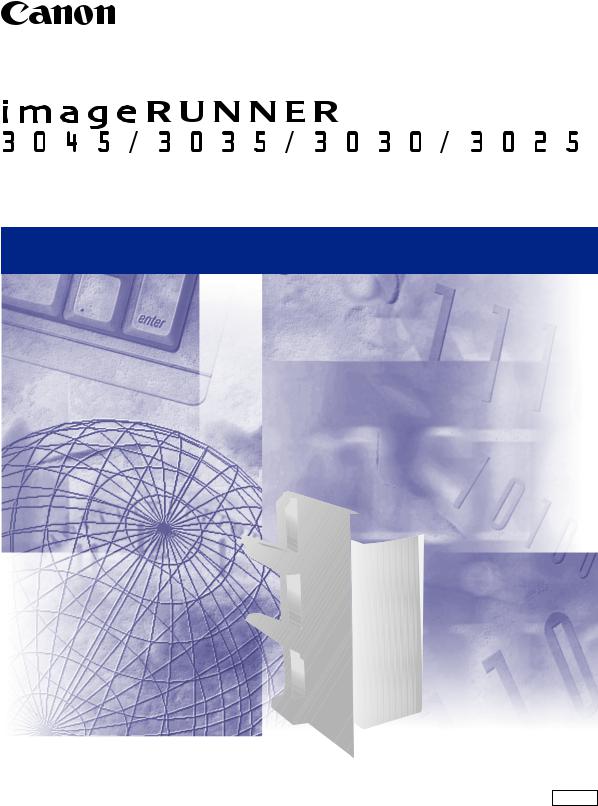
Remote UI Guide
Please read this guide before operating this product. |
ENG |
After you finish reading this guide, store it in a safe place for future reference. |
imageRUNNER 3045/3035/3030/3025
Remote UI Guide





 Manuals for the Machine
Manuals for the Machine
The manuals for this machine are divided as follows. Please refer to them for detailed information.
The manuals supplied with optional equipment are included in the list below. Depending on the system configuration and product purchased, some manuals may not be needed.
Guides with this symbol are printed manuals.
Guides with this symbol are included on the accompanying CD-ROM CD-ROM. (See footnote on the next page.)
•Quick Reference for Basic Operations
•Learn How to Use Your Machine
The Tutorial CD is a teaching aid, designed to help you learn the various functions of the machine.
•Basic Operations
•Troubleshooting
•Copying and Mail Box Instructions
•Sending and Fax Instructions
•Setting Up the Network Connection and Installing the CD-ROM Software
•Remote User Interface Instructions
•Network Connectivity and Setup Instructions
•Network ScanGear Installation and Instructions
•PS/PCL/UFR II Printer Instructions
•PCL Printer Driver Installation and Instructions
•PS Printer Driver Installation and Instructions
Easy Operation Guide
Tutorial CD
Reference Guide
Copying and Mail Box
Guide
Sending and Facsimile
Guide
Network Quick Start Guide
Remote UI Guide
(This Document)
Network Guide
Network ScanGear
User's Guide
PS/PCL/UFR II Printer
Guide
PCL Driver Guide
PS Driver Guide
CD-ROM
CD-ROM
CD-ROM
CD-ROM
CD-ROM
CD-ROM
CD-ROM
CD-ROM
CD-ROM
CD-ROM
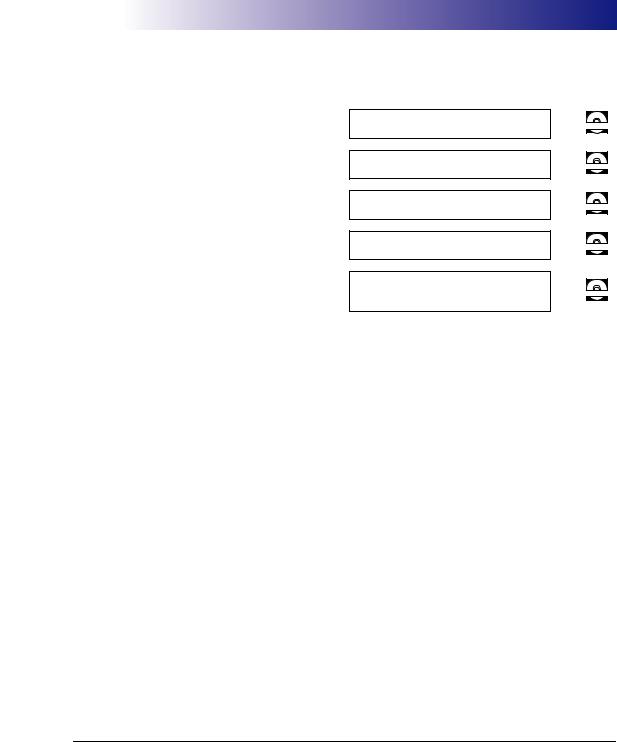
•UFR II Printer Driver Installation and Instructions
•Mac OS X PS Driver Installation and Instruction
•Mac OS X UFR II Driver Installation and Instructions
•Fax Driver Installation and Instructions
•Installing MEAP Applications and Using the Login Service
UFR II Driver Guide
Mac PS Driver Guide
Mac UFR II Driver Guide
Fax Driver Guide
MEAP SMS Administrator
Guide
CD-ROM
CD-ROM
CD-ROM
CD-ROM
CD-ROM
•To view the manual in PDF format, Adobe Reader/Acrobat Reader/Acrobat is required. If Adobe Reader/Acrobat Reader/Acrobat is not installed on your system, please download it from the Adobe Systems Incorporated website (http://www.adobe.com).
•The machine illustration on the cover may differ slightly from your machine.
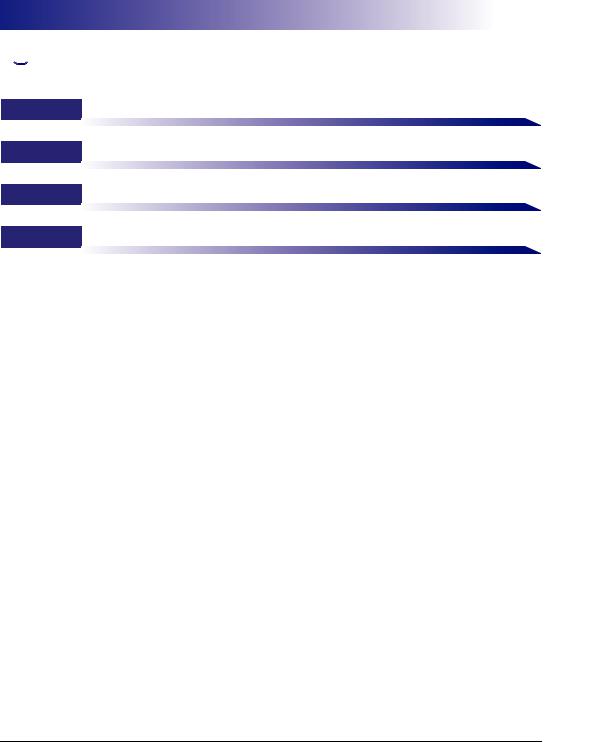




 How This Manual Is Organized
How This Manual Is Organized
Chapter 1 Using the Remote UI
Chapter 2 Checking and Managing Functions
Chapter 3 Customizing Settings
Chapter 4 Appendix
Includes the glossary and index.
Considerable effort has been made to ensure that this manual is free of inaccuracies and omissions. However, as we are constantly improving our products, if you need an exact specification, please contact Canon.
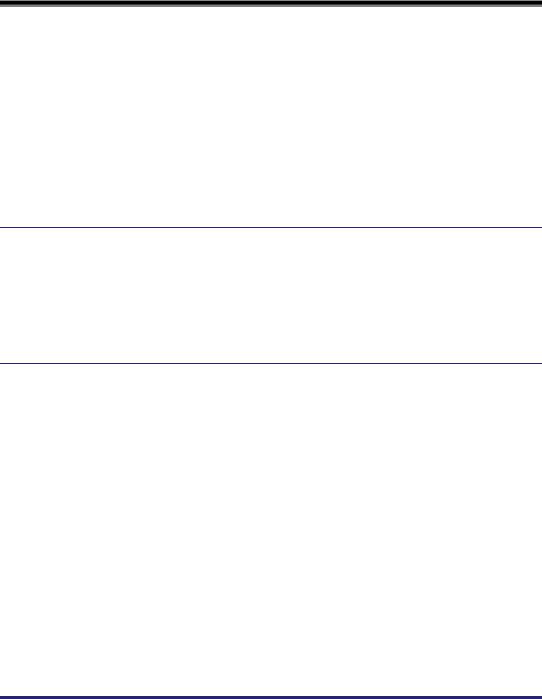
Contents
Preface . . . . . . . . . . . . . . . . . . . . . . . . . . . . . . . . . . . . . . . . . . . . . . . . . . . . . . . . . vii How To Use This Manual. . . . . . . . . . . . . . . . . . . . . . . . . . . . . . . . . . . . . . . . . . . vii
Symbols Used in This Manual . . . . . . . . . . . . . . . . . . . . . . . . . . . . . . . . . . . . . .vii Keys and Buttons Used in This Manual . . . . . . . . . . . . . . . . . . . . . . . . . . . . . . viii Displays Used in This Manual . . . . . . . . . . . . . . . . . . . . . . . . . . . . . . . . . . . . . . ix Abbreviations Used in This Manual . . . . . . . . . . . . . . . . . . . . . . . . . . . . . . . . . . x
Legal Notices . . . . . . . . . . . . . . . . . . . . . . . . . . . . . . . . . . . . . . . . . . . . . . . . . . . . . xi
Trademarks . . . . . . . . . . . . . . . . . . . . . . . . . . . . . . . . . . . . . . . . . . . . . . . . . . . . xi Copyright . . . . . . . . . . . . . . . . . . . . . . . . . . . . . . . . . . . . . . . . . . . . . . . . . . . . . . xi Disclaimers . . . . . . . . . . . . . . . . . . . . . . . . . . . . . . . . . . . . . . . . . . . . . . . . . . . .xii
Chapter 1 Using the Remote UI
Overview of the Remote UI . . . . . . . . . . . . . . . . . . . . . . . . . . . . . . . . . . . . . . . . . 1-2
System Requirements. . . . . . . . . . . . . . . . . . . . . . . . . . . . . . . . . . . . . . . . . . . . . 1-8
Before You Start the Remote UI . . . . . . . . . . . . . . . . . . . . . . . . . . . . . . . . . . . . . 1-9
Enabling the Remote UI. . . . . . . . . . . . . . . . . . . . . . . . . . . . . . . . . . . . . . . . . 1-10
Starting the Remote UI . . . . . . . . . . . . . . . . . . . . . . . . . . . . . . . . . . . . . . . . . . . 1-12
Chapter 2 Checking and Managing Functions
Device Status and Information Display . . . . . . . . . . . . . . . . . . . . . . . . . . . . . . . 2-2
Job Management . . . . . . . . . . . . . . . . . . . . . . . . . . . . . . . . . . . . . . . . . . . . . . . . . 2-4
Managing Print Jobs . . . . . . . . . . . . . . . . . . . . . . . . . . . . . . . . . . . . . . . . . . . . 2-5
Managing Copy, Send, and Fax Jobs . . . . . . . . . . . . . . . . . . . . . . . . . . . . . . . 2-8
Managing Receive Jobs. . . . . . . . . . . . . . . . . . . . . . . . . . . . . . . . . . . . . . . . . 2-10
Managing Inboxes . . . . . . . . . . . . . . . . . . . . . . . . . . . . . . . . . . . . . . . . . . . . . . . 2-12
User Inboxes . . . . . . . . . . . . . . . . . . . . . . . . . . . . . . . . . . . . . . . . . . . . . . . . . 2-13
Memory RX Inbox . . . . . . . . . . . . . . . . . . . . . . . . . . . . . . . . . . . . . . . . . . . . . 2-18
Memory RX Inbox. . . . . . . . . . . . . . . . . . . . . . . . . . . . . . . . . . . . . . . . . . . 2-18
Divided Data RX Inbox. . . . . . . . . . . . . . . . . . . . . . . . . . . . . . . . . . . . . . . 2-21
Confidential Fax Inboxes . . . . . . . . . . . . . . . . . . . . . . . . . . . . . . . . . . . . . . . . 2-22
Printing PDF, PS, or Image Files Directly (Direct Print) . . . . . . . . . . . . . . . . . 2-24
Printing PDF Files Directly. . . . . . . . . . . . . . . . . . . . . . . . . . . . . . . . . . . . . . . 2-25 Printing PS Files Directly . . . . . . . . . . . . . . . . . . . . . . . . . . . . . . . . . . . . . . . . 2-26 Printing Image Files Directly . . . . . . . . . . . . . . . . . . . . . . . . . . . . . . . . . . . . . 2-27
Managing the Address Book . . . . . . . . . . . . . . . . . . . . . . . . . . . . . . . . . . . . . . 2-29
v

Operating the Address Book . . . . . . . . . . . . . . . . . . . . . . . . . . . . . . . . . . . . .2-30
Operating the System Reference Address Book . . . . . . . . . . . . . . . . . . . . . .2-34
Chapter 3 Customizing Settings
Customizing System Settings . . . . . . . . . . . . . . . . . . . . . . . . . . . . . . . . . . . . . .3-2
Customizing System Information . . . . . . . . . . . . . . . . . . . . . . . . . . . . . . . . . . .3-2
Restarting the Machine . . . . . . . . . . . . . . . . . . . . . . . . . . . . . . . . . . . . . . . . . .3-8
Specifying LDAP Server Settings. . . . . . . . . . . . . . . . . . . . . . . . . . . . . . . . . . .3-10
Specifying Forwarding Settings . . . . . . . . . . . . . . . . . . . . . . . . . . . . . . . . . . . .3-13
Managing Department IDs. . . . . . . . . . . . . . . . . . . . . . . . . . . . . . . . . . . . . . . . .3-18
Import/Export Function . . . . . . . . . . . . . . . . . . . . . . . . . . . . . . . . . . . . . . . . . . .3-22
Saving the Address Book . . . . . . . . . . . . . . . . . . . . . . . . . . . . . . . . . . . . . . . .3-23
Loading an Address Book . . . . . . . . . . . . . . . . . . . . . . . . . . . . . . . . . . . . . . .3-25
Saving Forwarding Settings in Files (Export) . . . . . . . . . . . . . . . . . . . . . . . . .3-28
Loading a Forwarding Settings File (Overwrite/Import) . . . . . . . . . . . . . . . . .3-29
Saving Additional Functions Settings in Files (Export). . . . . . . . . . . . . . . . . .3-31
Loading Additional Functions Settings Files (Overwrite/Import) . . . . . . . . . .3-32
Saving the Printer Settings. . . . . . . . . . . . . . . . . . . . . . . . . . . . . . . . . . . . . . .3-34
Loading Printer Settings. . . . . . . . . . . . . . . . . . . . . . . . . . . . . . . . . . . . . . . . .3-35
Device Custom Settings . . . . . . . . . . . . . . . . . . . . . . . . . . . . . . . . . . . . . . . . . .3-36
Backing Up Inbox Documents . . . . . . . . . . . . . . . . . . . . . . . . . . . . . . . . . . . . .3-39
Setting the Backup Destination for Inbox Documents . . . . . . . . . . . . . . . . . .3-40
Performing the Inbox Document Backup . . . . . . . . . . . . . . . . . . . . . . . . . . . .3-42
Restoring Backed Up Data. . . . . . . . . . . . . . . . . . . . . . . . . . . . . . . . . . . . . . .3-43
Installing a Certificate File . . . . . . . . . . . . . . . . . . . . . . . . . . . . . . . . . . . . . . . .3-44
Installing a Key Pair and Server Certificate . . . . . . . . . . . . . . . . . . . . . . . . . .3-44 Installing a CA Certificate. . . . . . . . . . . . . . . . . . . . . . . . . . . . . . . . . . . . . . . .3-46 Installing/Checking/Erasing a User Signature Certificate and Key Pair . . . . .3-47
Chapter 4 Appendix
Glossary . . . . . . . . . . . . . . . . . . . . . . . . . . . . . . . . . . . . . . . . . . . . . . . . . . . . . . . .4-2
Index . . . . . . . . . . . . . . . . . . . . . . . . . . . . . . . . . . . . . . . . . . . . . . . . . . . . . . . . . .4-11
vi
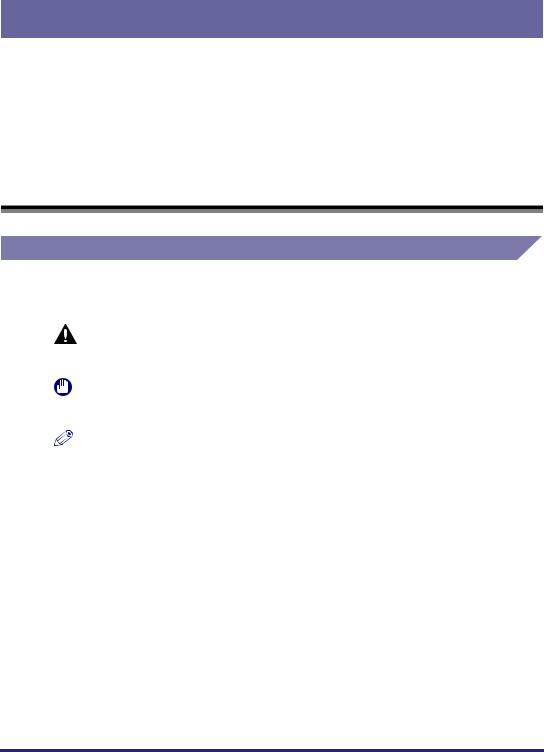
Preface
Thank you for purchasing the Canon imageRUNNER 3045/3035/3030/3025. Please read this manual thoroughly before operating the product to familiarize yourself with its capabilities, and to make the most of its many functions. After reading this manual, store it in a safe place for future reference.
How To Use This Manual
Symbols Used in This Manual
The following symbols are used in this manual to explain procedures, restrictions, handling precautions, and instructions that should be observed for safety.
CAUTION |
Indicates a caution concerning operations that may lead to injury to |
|
|
persons, or damage to property if not performed correctly. To use the |
|
|
machine safely, always pay attention to these cautions. |
|
IMPORTANT |
Indicates operational requirements and restrictions. Be sure to read |
|
|
these items carefully to operate the product correctly, and avoid damage |
|
|
to the product. |
|
NOTE |
Indicates a clarification of an operation, or contains additional |
|
explanations for a procedure. Reading these notes is highly |
||
|
||
|
recommended. |
vii
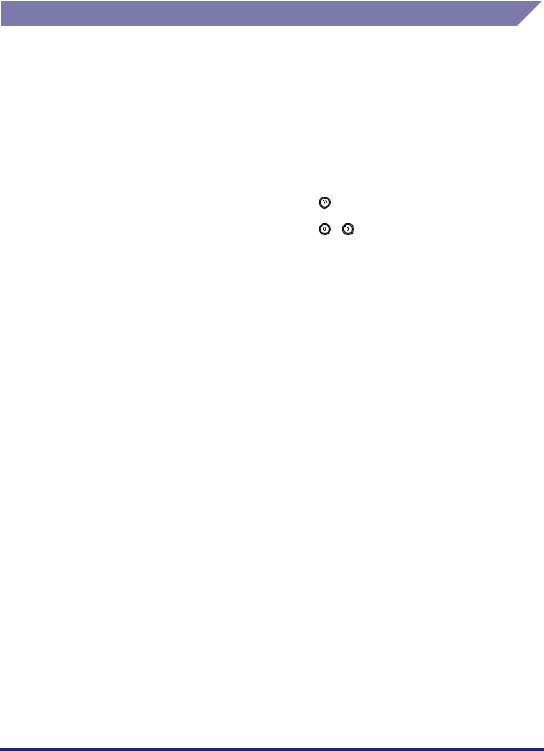
Keys and Buttons Used in This Manual
The following symbols and key/button names are a few examples of how keys and buttons to be pressed are expressed in this manual:
• Touch Panel Display Keys: |
[Key Name] |
Examples: |
[System Settings] |
|
[Done] |
• Control Panel Keys: |
Key Icon (Key Name) |
Examples: |
(Additional Functions) |
|
- (Numeric Keys) |
• Buttons on Computer Operation Screens: [Button Name] |
|
Examples: |
[Job Status] |
|
[OK] |
viii
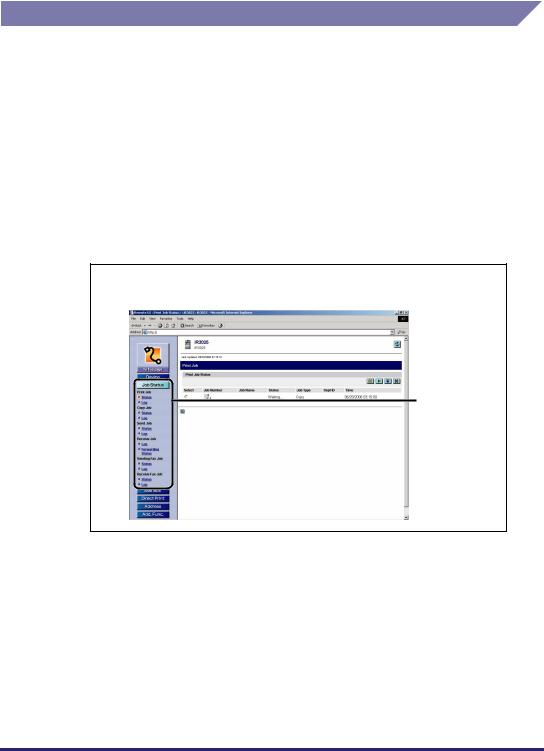
Displays Used in This Manual
Screen shots used in this manual are those taken when the following optional equipment is attached to the imageRUNNER 3025: the Super G3 FAX Board, PS Printer Kit, Finisher-S1, Additional Finisher Tray-B1, Copy Tray-J1, and Cassette Feeding Unit-Y3.
Functions that are unavailable due to a particular combination of accessories and optional equipment are not displayed on the web browser. Therefore, screen shots of computer operation screens used in this manual may differ from the ones you actually see, depending on the model or options that come with your machine.
The keys or buttons that you need to click during the procedure are marked with a  , as shown in the example below. If multiple keys or buttons can be clicked, they
, as shown in the example below. If multiple keys or buttons can be clicked, they
are all enclosed within a  . Select the appropriate key or button according to your needs.
. Select the appropriate key or button according to your needs.
1Click [Job Status] Click [Status] or [Log] from the menu that appears under [Print Job].
Click one of these keys for operation.
ix

Abbreviations Used in This Manual
In this manual, product names and model names are abbreviated as follows:
Microsoft® Windows® 2000 operating system:
Microsoft® Windows® 98 operating system:
Microsoft® Windows® Millennium Edition operating system: Microsoft® Windows® XP Home Edition operating system: Microsoft® Windows® XP Professional Edition operating system: Microsoft® Windows® operating system:
Apple Macintosh:
Windows 2000
Windows 98
Windows Me
Windows XP
Windows XP
Windows
Mac
x

Legal Notices
Trademarks
Canon, the Canon logo, imageRUNNER, and MEAP are trademarks of Canon Inc.
Adobe, Adobe Acrobat, and PostScript are trademarks of Adobe Systems Incorporated.
Macintosh, Mac OS, and QuickTime are trademarks of Apple Computer, Inc.
Active Directory, Microsoft, and Windows are registered trademarks of Microsoft Corporation in the United States and other countries.
Netscape, Netscape Communicator, and Netscape Navigator are trademarks of Netscape Communications Corporation.
Java and all Java-based trademarks and logos are trademarks or registered trademarks of Sun Microsystems, Inc. in the United States and other countries.
Other product and company names herein may be the trademarks of their respective owners.
Copyright
Copyright 2006 by Canon Inc. All rights reserved.
No part of this publication may be reproduced or transmitted in any form or by any means, electronic or mechanical, including photocopying and recording, or by any information storage or retrieval system without the prior written permission of Canon Inc.
xi

Disclaimers
The information in this document is subject to change without notice.
CANON INC. MAKES NO WARRANTY OF ANY KIND WITH REGARD TO THIS MATERIAL, EITHER EXPRESS OR IMPLIED, EXCEPT AS PROVIDED HEREIN, INCLUDING WITHOUT LIMITATION, THEREOF, WARRANTIES AS TO MARKETABILITY, MERCHANTABILITY, FITNESS FOR A PARTICULAR PURPOSE OF USE OR NON-INFRINGEMENT. CANON INC. SHALL NOT BE LIABLE FOR ANY DIRECT, INCIDENTAL, OR CONSEQUENTIAL DAMAGES OF ANY NATURE, OR LOSSES OR EXPENSES RESULTING FROM THE USE OF THIS MATERIAL.
xii
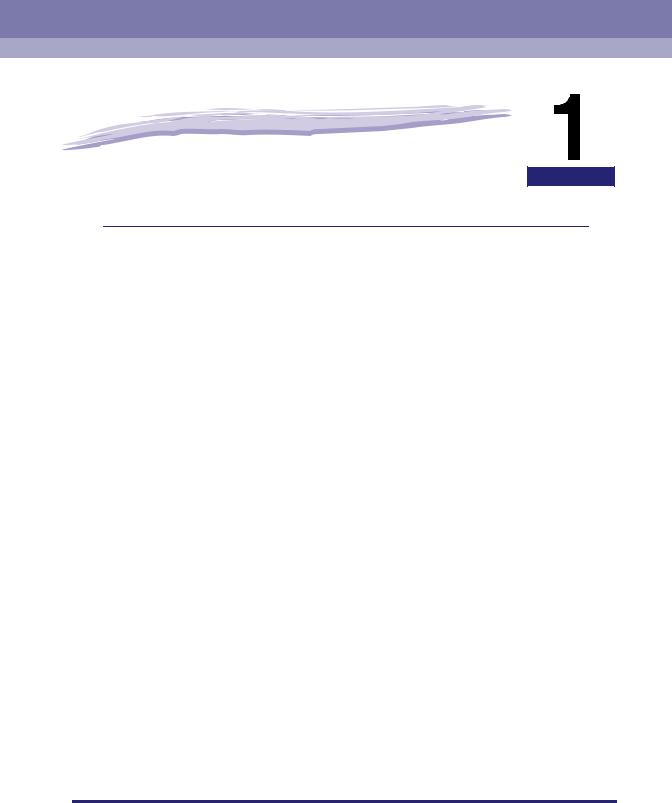
Using the Remote UI
CHAPTER
This chapter describes the features and benefits of the Remote UI, and how to start it.
Overview of the Remote UI. . . . . . . . . . . . . . . . . . . . . . . . . . . . . . . . . . . . . . . . . . . . . . . . 1-2
System Requirements . . . . . . . . . . . . . . . . . . . . . . . . . . . . . . . . . . . . . . . . . . . . . . . . . . . 1-8
Before You Start the Remote UI . . . . . . . . . . . . . . . . . . . . . . . . . . . . . . . . . . . . . . . . . . . . 1-9
Enabling the Remote UI . . . . . . . . . . . . . . . . . . . . . . . . . . . . . . . . . . . . . . . . . . . . . . . . . . . . . . .1-10
Starting the Remote UI . . . . . . . . . . . . . . . . . . . . . . . . . . . . . . . . . . . . . . . . . . . . . . . . . . 1-12
1-1
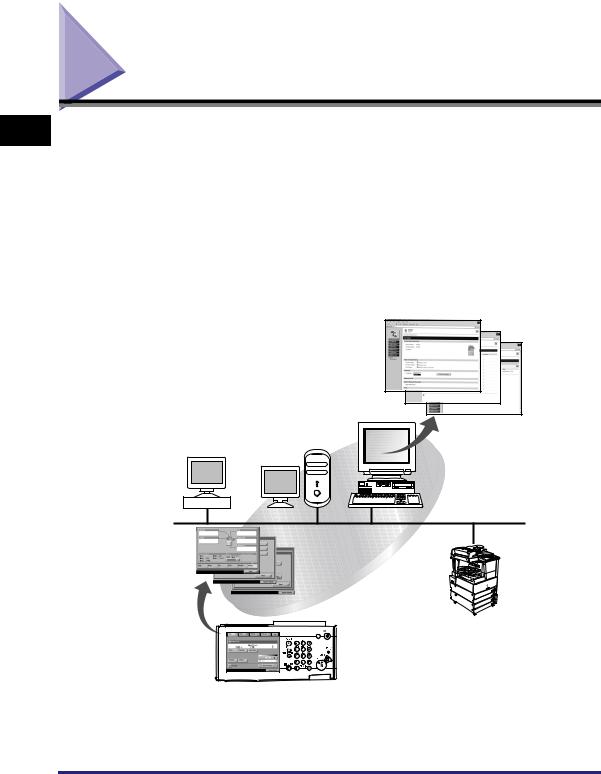
1
Using the Remote UI
Overview of the Remote UI
The Remote UI (User Interface) is preinstalled software in the machine that enables you to access the machine's functions by using a web browser. For example, the Remote UI enables you to access the machine to check job status, execute jobs, and specify various settings. To be able to use the Remote UI, all you need is a web browser and a network connection between your computer and the machine.
In order to use the Remote UI, you must first enter an IP (Internet Protocol) address for the machine from the control panel and set up the necessary network connection. Once this is achieved, start your web browser and enter the machine's IP address. The Remote UI screen appears on your computer screen and is ready for use.
You can operate the machine through the Remote UI from a PC using a web browser.
PC Screen Shots
Windows Macintosh
PC Connected to Network
Touch Panel Display
Screen Shots
imageRUNNER 3045/3035/3030/3025
You can operate the machine from the







 control panel and touch panel display. Control Panel of Machine
control panel and touch panel display. Control Panel of Machine
1-2 Overview of the Remote UI
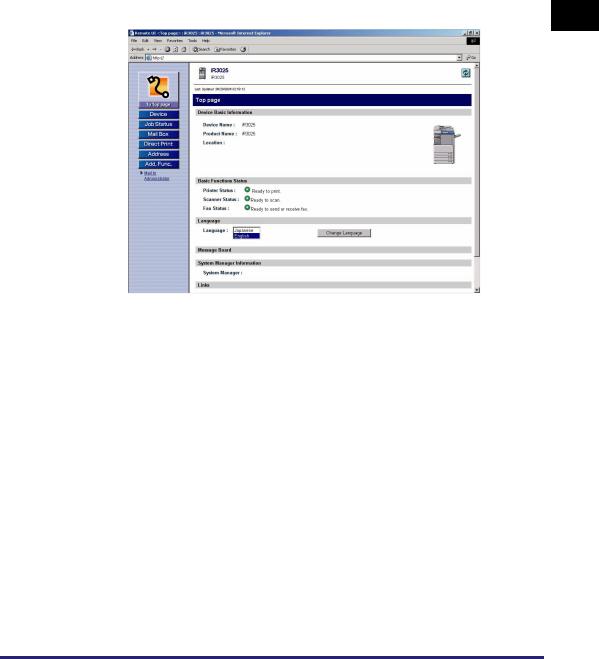
■Checking the Status of the Machine from a Networked Computer
The Remote UI enables you to access the machine via a network, enabling you to display the current status and settings for the machine, and the status of all information and job processing. You can manage the machine from a computer connected to the network without having to perform operations on the machine itself.
When you enter the machine's IP address into your web browser, the Remote UI's top page or main screen is displayed on your computer screen, as shown below:
1
Using the Remote UI
Overview of the Remote UI |
1-3 |
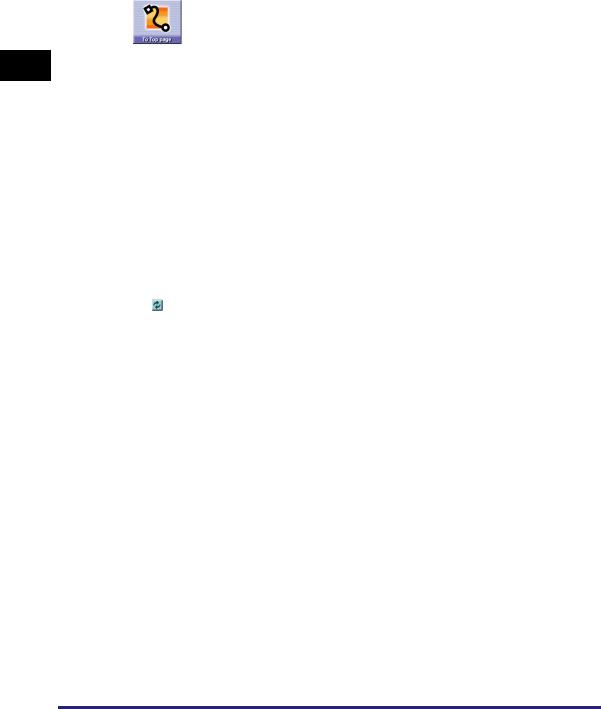
1
Using the Remote UI
The left column of the Remote UI's top page contains the function buttons, which allow you to navigate the functions of the Remote UI.
Takes you to the Remote UI top page.
Displays information such as the product name, printer status, scanner status, and fax status.
 Displays the machine's current status, settings information, and the optional equipment that is attached to the machine.
Displays the machine's current status, settings information, and the optional equipment that is attached to the machine.
 Displays the current status of jobs, and permits changes to jobs being processed by the machine.
Displays the current status of jobs, and permits changes to jobs being processed by the machine.
 Enables you to print, duplicate, delete, or send documents stored in inboxes.
Enables you to print, duplicate, delete, or send documents stored in inboxes.
 Enables you to print PDF (Portable Document Format), PS (PostScript), and image files that are stored in your computer or on the network without opening the files. The Direct Print function is available for PDF and PS files only if the optional PS Printer Kit is activated.
Enables you to print PDF (Portable Document Format), PS (PostScript), and image files that are stored in your computer or on the network without opening the files. The Direct Print function is available for PDF and PS files only if the optional PS Printer Kit is activated.
 Enables you to manage the machine's Address Book, including the storing and editing of addresses.
Enables you to manage the machine's Address Book, including the storing and editing of addresses.
 Enables you to specify or change various system settings on the machine.
Enables you to specify or change various system settings on the machine.
This updates or refreshes the currently displayed screen with the latest information. Information is not updated automatically. When you click this button, the latest information from the machine is acquired.
 NOTE
NOTE
•You can change the language displayed on the screen by selecting the desired language and clicking [Change Language], regardless of the language used on the touch panel display of the machine.
•If you change the language, characters of the displayed language can be entered. However, if the displayed language is different from the language used on the touch panel display of the machine, the language may not be displayed correctly.
•If Language Switch is set to 'On' from the touch panel of the machine, some characters are restricted and cannot be entered.
■Setting and Controlling the Machine from a Computer
The Remote UI enables you to pause and resume jobs, view and print jobs stored in inboxes, and change various settings from a computer without using the machine's control panel.
1-4 Overview of the Remote UI
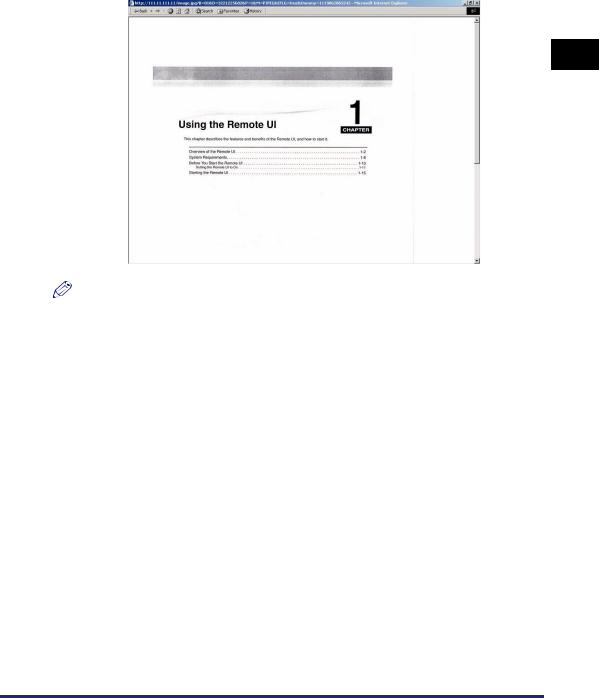
■Viewing documents stored in inboxes on your computer screen
You can view documents in the machine's inboxes in the TIFF format by clicking [Mail Box].
1
Using the Remote UI
NOTE
•To view images in the TIFF format, you need an application that supports the TIFF format (e.g., Imaging for Windows).
•To view images on a Macintosh, you need an application that supports the TIFF formats. If you use QuickTime, version 6.0.1 or later is required.
Overview of the Remote UI |
1-5 |
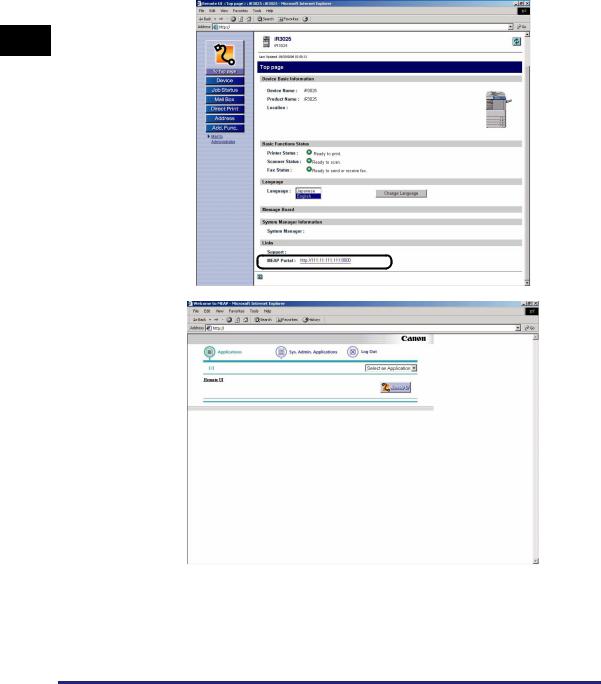
■Link to MEAP Portal
A list of the MEAP (Multifunctional Embedded Application Platform) applications can be displayed by clicking [http://<the IP address of the device:8000>/] for Link to MEAP Portal on the top page of the Remote UI.
1
Using the Remote UI
1-6 Overview of the Remote UI

 NOTE
NOTE
•You can set a MEAP application for administrator/system manager only, if you enter the authentication login screen as an Administrator. (See the MEAP SMS Administrator Guide.)
•If Department ID Management is set to 'Off' and a System Manager is not specified,
depending on the login services you are using, all users may be considered as Administrators without authentication. (See Chapter 6, "System Manager Settings," in the Reference Guide.)
•[Link to MEAP Portal] appears only if a MEAP application called "PortalService" is installed on the machine. PortalService can be installed using the MEAP Administration Software CD-ROM.
1
Using the Remote UI
Overview of the Remote UI |
1-7 |

1
Using the Remote UI
System Requirements
The system requirements for the Remote UI are as follows:
■Windows
•OS (Operating System)
-Microsoft Windows 98
-Microsoft Windows 2000 Professional
-Microsoft Windows Me
-Microsoft Windows XP
•Web Browser
-Microsoft Internet Explorer 5.01 SP2, or later
-Netscape Communicator 4.6, or later
■Macintosh
•OS (Operating System)
-Mac OS 8.6, or later
•Web Browser
-Microsoft Internet Explorer 5.0, or later
 IMPORTANT
IMPORTANT
•Available browsers may be limited depending on the login services for the MEAP function you are using. For instructions on how to use the login services, see the MEAP SMS Administrator Guide.
•If you are using Netscape 6.2, click [Edit] select [Preferences] click [Advanced] menu under Category click [Cache] set [Compare the page in the cache to the page on the network] to [Once per session] or [Never]. If you do not make this setting, you may have problems accessing the machine using other web browsers.
 NOTE
NOTE
Apart from those mentioned above, no other software, such as a web server, is necessary. (There already is a web server inside the machine.)
1-8 System Requirements

Before You Start the Remote UI
Before you start the Remote UI, perform the following:
■Specify the Network Settings
Specify the settings under Network Settings in System Settings (from the Additional Functions screen) and find out the machine's IP address. If you do not know the machine's IP address, consult your network administrator. (See Chapter 3, "Using a TCP/ IP Network," in the Network Guide.)
■MEAP Settings
Set Use HTTP in MEAP Settings in System Settings (from the Additional Functions screen) to 'On'. (See Chapter 6, "System Manager Settings," in the Reference Guide.) If you are using a default authentication, you do not need to set Use HTTP to 'On'.
■Enable the Remote UI
Set Remote UI in System Settings (from the Additional Functions screen) to 'On'. It is also recommended that Device Information Settings in System Settings is configured.
 IMPORTANT
IMPORTANT
•Connection via a proxy server is not possible. If your system environment has a proxy server, perform the following setting. (Settings vary according to the system environment, consult your network administrator.)
-Enter the IP address of the machine into Exceptions in the web browser proxy server settings.
•You must set your web browser to enable all cookies and use JavaScript. Otherwise, you will not be able to change the machine's settings using the Remote UI.
•If the control panel of the machine is being used for a particular operation, you cannot perform the same operation using the Remote UI.
•If multiple Remote UIs are running simultaneously, the latest setting that was made is enabled. It is recommended that only one Remote UI be running at a time.
•To enter characters from a web browser, use the characters that you can enter from the touch panel display of the machine. If you use the other characters, they may not be displayed/recognized properly on the machine.
1
Using the Remote UI
Before You Start the Remote UI |
1-9 |

1
Using the Remote UI
Enabling the Remote UI
You must use the machine's control panel to enable the Remote UI.
1 Press  (Additional Functions) [System Settings]
(Additional Functions) [System Settings]
[Remote UI].
If the System Manager ID and System Password have already been set, enter the System Manager ID and System Password using  -
-  (numeric keys) press
(numeric keys) press  (Log In/Out).
(Log In/Out).
NOTE
If the desired setting is not displayed, press [▼] or [▲] to scroll to the desired setting.
2 Select [On] select whether to use SSL.
Select [Off] to disable the Remote UI.
<Use SSL>:
[On]: Allows secured transmission using SSL.
[Off]: Prohibits secured transmission using SSL.
NOTE
Any changes made to <Use SSL> are also applied to <Use SSL> in <Use HTTP> in MEAP Settings in System Settings (from the Additional Functions screen).
3 Press [Done] repeatedly until the Basic Features screen appears.
1-10 Before You Start the Remote UI

4 Turn OFF the main power of the machine, wait 10 seconds, and then turn ON the main power.
 IMPORTANT
IMPORTANT
The [Remote UI] setting is made effective only after turning the machine's main power OFF, and then ON.
NOTE
For information on how to turn ON and OFF the main power of the machine, see Chapter 1, "Before You Start Using This Machine," in the Reference Guide.
1
Using the Remote UI
Before You Start the Remote UI |
1-11 |
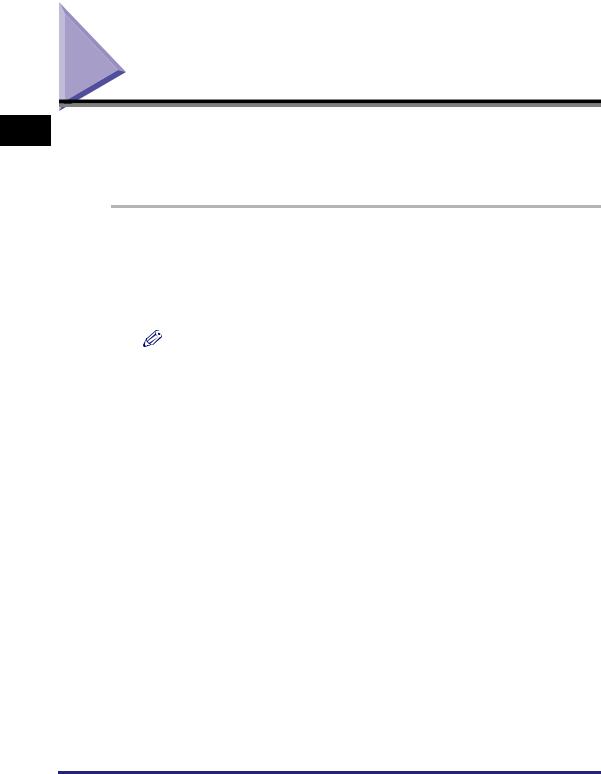
1
Using the Remote UI
Starting the Remote UI
To start the Remote UI, follow the procedure described below.
 NOTE
NOTE
For details of selection and setting of a login service, consult your system administrator.
1 Start your web browser.
2 Enter the appropriate URL into [Address] or [Location].
http://<the IP address of the device>/
NOTE
•If a login service is not set, it is unnecessary to proceed to step 3. However, if System Manager Settings is set, log in using the contents set for the settings, or click [Cancel] without logging in.
•If you do not know the appropriate URL, consult your system administrator.
1-12 Starting the Remote UI
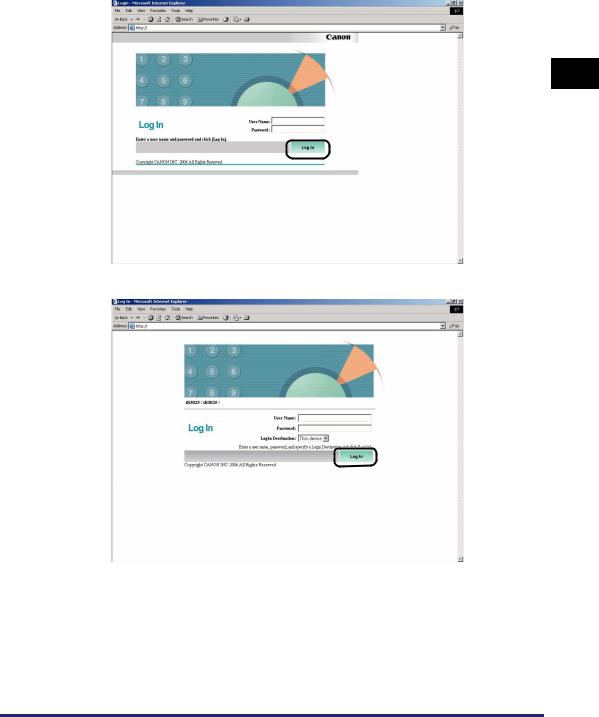
3 Enter the required data click [Log In].
1
Using the Remote UI
SDL is set as a login service.
SSO is set as a login service.
Starting the Remote UI |
1-13 |
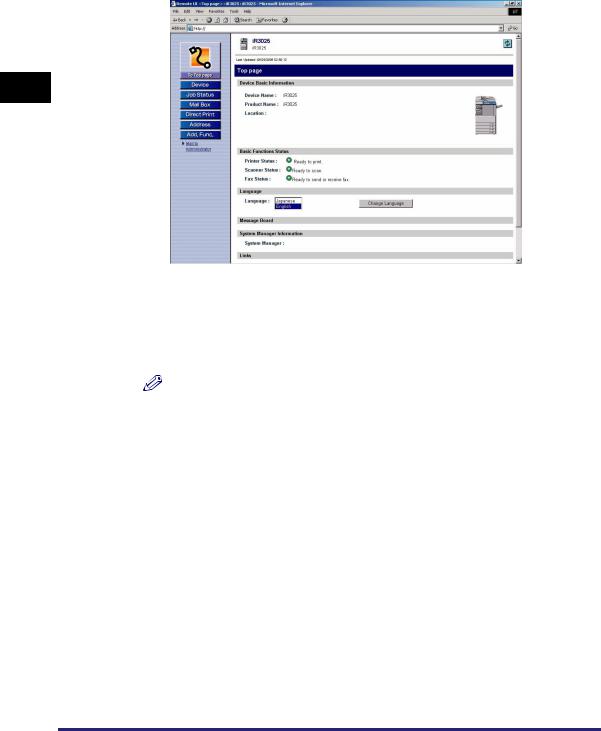
The Remote UI screen is displayed.
1
Using the Remote UI
 IMPORTANT
IMPORTANT
If there is more than a 30 minute difference between the current time set in the computer register by the Active Directory and the time set in the computer that you use for login, an error occurs when you log in using SSO. To be able to log in using SSO, it is necessary to match the current time on both the computers.
NOTE
•If Default Authentication is set, and an ID and password for the system manager in the System Manager Settings (from the Additional Functions screen of the machine) have been set, a dialog box requesting a user name and password appears. Enter the system manager ID and password, and click [OK] to start the Remote UI.
•You must use the user login name (pre-Windows 2000) registered in Active Directory in order to then enter a user name for SSO authentication.
•You can use only alphanumeric characters, . (period), - (hyphen), or _ (underscore) for a user name for SSO authentication. You can log in only if you use valid characters.
•You can select up to four trusted domain names in addition to the domain name the machine belongs to for the DNS Domain Name.
•Even if you install multiple login services, they cannot be used simultaneously. Only the login screen for the set login service is displayed.
1-14 Starting the Remote UI
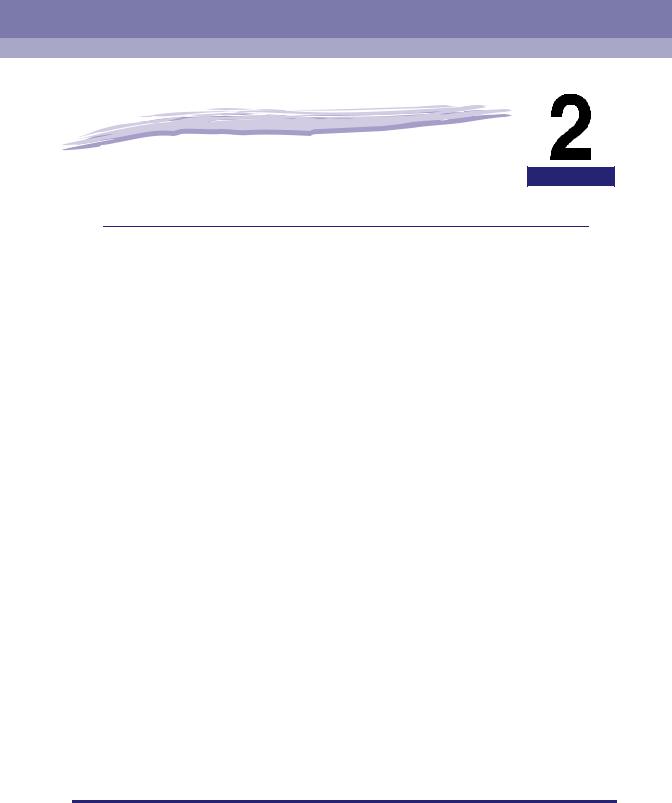
Checking and Managing
Functions
CHAPTER
This chapter describes the various functions for checking and managing the Remote UI.
Device Status and Information Display . . . . . . . . . . . . . . . . . . . . . . . . . . . . . . . . . . . . . . . 2-2
Job Management . . . . . . . . . . . . . . . . . . . . . . . . . . . . . . . . . . . . . . . . . . . . . . . . . . . . . . . 2-4
Managing Print Jobs. . . . . . . . . . . . . . . . . . . . . . . . . . . . . . . . . . . . . . . . . . . . . . . . . . . . . . . . . . .2-5
Managing Copy, Send, and Fax Jobs . . . . . . . . . . . . . . . . . . . . . . . . . . . . . . . . . . . . . . . . . . . . . .2-8
Managing Receive Jobs . . . . . . . . . . . . . . . . . . . . . . . . . . . . . . . . . . . . . . . . . . . . . . . . . . . . . . .2-10
Managing Inboxes. . . . . . . . . . . . . . . . . . . . . . . . . . . . . . . . . . . . . . . . . . . . . . . . . . . . . . 2-12
User Inboxes. . . . . . . . . . . . . . . . . . . . . . . . . . . . . . . . . . . . . . . . . . . . . . . . . . . . . . . . . . . . . . . .2-13
Memory RX Inbox. . . . . . . . . . . . . . . . . . . . . . . . . . . . . . . . . . . . . . . . . . . . . . . . . . . . . . . . . . . .2-18
Confidential Fax Inboxes . . . . . . . . . . . . . . . . . . . . . . . . . . . . . . . . . . . . . . . . . . . . . . . . . . . . . .2-22
Printing PDF, PS, or Image Files Directly (Direct Print) . . . . . . . . . . . . . . . . . . . . . . . . . 2-24
Printing PDF Files Directly . . . . . . . . . . . . . . . . . . . . . . . . . . . . . . . . . . . . . . . . . . . . . . . . . . . . .2-25
Printing PS Files Directly . . . . . . . . . . . . . . . . . . . . . . . . . . . . . . . . . . . . . . . . . . . . . . . . . . . . . .2-26
Printing Image Files Directly. . . . . . . . . . . . . . . . . . . . . . . . . . . . . . . . . . . . . . . . . . . . . . . . . . . .2-27
Managing the Address Book. . . . . . . . . . . . . . . . . . . . . . . . . . . . . . . . . . . . . . . . . . . . . . 2-29
Operating the Address Book . . . . . . . . . . . . . . . . . . . . . . . . . . . . . . . . . . . . . . . . . . . . . . . . . . .2-30 Operating the System Reference Address Book . . . . . . . . . . . . . . . . . . . . . . . . . . . . . . . . . . . .2-34
2-1
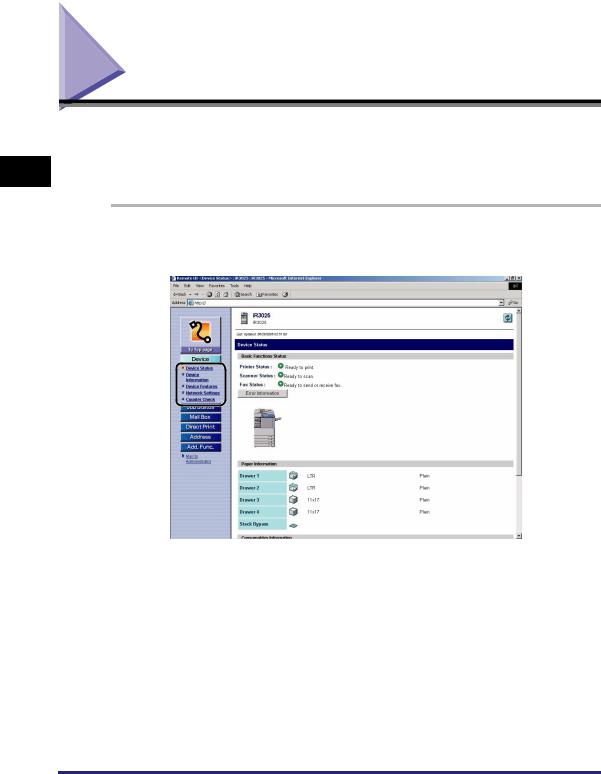
2
Checking and Managing Functions
Device Status and Information Display
You can use the Remote UI (User Interface) to check the machine's current status, such as the amount of paper remaining in the various paper sources, and to check for any errors. You can also obtain information on the machine's system manager, the location where the machine is installed, and the machine's protocol settings.
1 Click [Device] select the item you want to display from the menu that appears under [Device].
2-2 Device Status and Information Display
